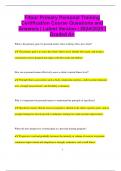Fitour Primary Personal Training
Certification Course Questions and
Answers | Latest Version | 2024/2025 |
Graded A+
What is the primary goal of a personal trainer when working with a new client?
✔✔ The primary goal is to assess the client's fitness level, identify their goals, and design a
customized exercise program that aligns with their needs and abilities.
How can a personal trainer effectively assess a client's current fitness level?
✔✔ Through fitness assessments such as body composition analysis, cardiovascular endurance
tests, strength measurements, and flexibility evaluations.
Why is it important for personal trainers to understand the principle of specificity?
✔✔ Specificity ensures that the exercise program is tailored to the client's specific goals, such as
strength training for muscle growth or endurance training for cardiovascular improvement.
What role does progressive overload play in a personal training program?
✔✔ Progressive overload gradually increases the intensity or volume of exercise to promote
continuous improvement and adaptation in strength, endurance, and overall fitness.
1
,How can a personal trainer help a client set realistic and achievable fitness goals?
✔✔ By using the SMART goal-setting framework (Specific, Measurable, Achievable, Relevant,
Time-bound), ensuring that goals are clear, attainable, and aligned with the client’s abilities.
What are common barriers to exercise that personal trainers should address with clients?
✔✔ Common barriers include time constraints, lack of motivation, fear of injury, and low self-
confidence. Trainers should offer solutions like time-efficient workouts and building a positive
mindset.
How can personal trainers motivate clients who are struggling to stay consistent with their
workout routines?
✔✔ By providing encouragement, tracking progress, celebrating small wins, and adjusting the
program to keep it engaging and aligned with the client's evolving interests.
What are the key components of a comprehensive fitness program designed by a personal
trainer?
✔✔ A comprehensive fitness program should include cardiovascular conditioning, resistance
training, flexibility work, and rest or recovery periods for balanced physical development.
2
,Why is proper form crucial during resistance training exercises?
✔✔ Proper form ensures the correct muscles are targeted, reduces the risk of injury, and
maximizes the effectiveness of each exercise.
How can a personal trainer ensure client safety during high-intensity interval training (HIIT)?
✔✔ By monitoring form closely, providing proper warm-ups and cool-downs, and ensuring
clients are performing exercises within their fitness level while progressing gradually.
What is the importance of a thorough client consultation before beginning a personal training
program?
✔✔ A consultation helps to understand the client's medical history, fitness goals, lifestyle, and
potential limitations, allowing the trainer to design a safe and effective program.
How can personal trainers modify exercises for clients with lower back pain or other chronic
conditions?
✔✔ Trainers should avoid exercises that exacerbate pain, emphasize core strengthening and
flexibility, and modify exercises to accommodate the client’s limitations while maintaining
proper alignment.
3
, Why should a personal trainer regularly reassess a client’s progress?
✔✔ Regular reassessments help track progress, ensure the program remains effective, and
provide opportunities to adjust the training plan based on the client’s improvements or changing
goals.
What is the role of cardiovascular endurance training in a personal training program?
✔✔ Cardiovascular endurance training improves heart and lung function, enhances overall
stamina, and supports weight management through calorie expenditure.
How can a personal trainer help clients incorporate nutrition into their fitness plan?
✔✔ While personal trainers must stay within their scope of practice, they can educate clients on
general healthy eating principles, encourage balanced nutrition, and refer them to a nutritionist if
needed.
What strategies can be used to prevent overtraining in clients?
✔✔ Strategies include scheduling adequate rest days, monitoring intensity and volume,
incorporating recovery techniques, and educating clients on listening to their bodies.
4




